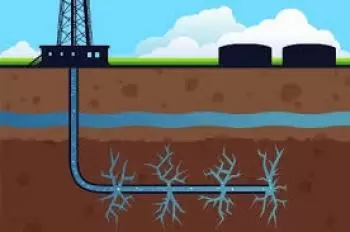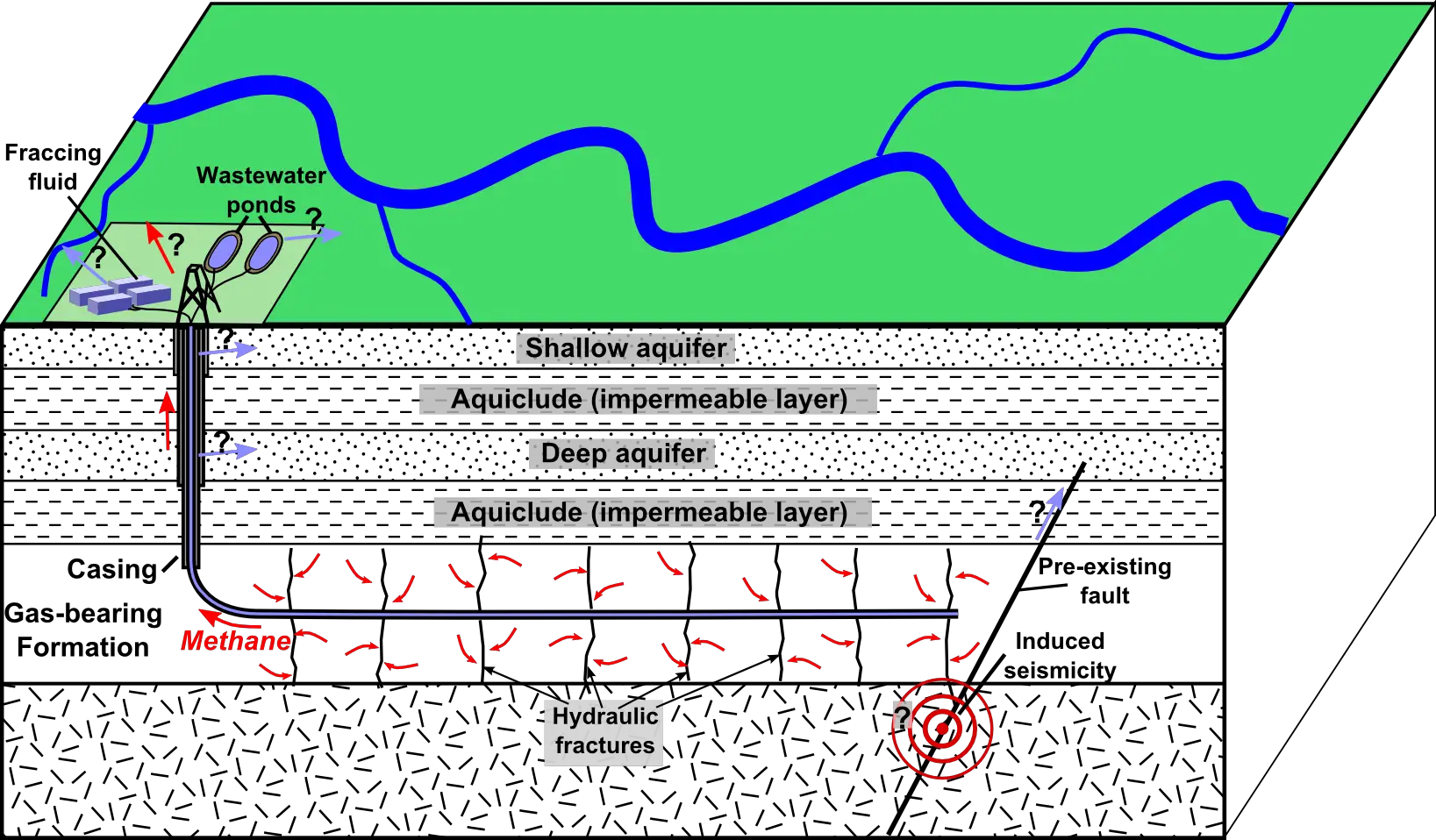
Hydraulic fracturing or fracking in geotechnical is the exploitation of the pressure of a fluid, typically water, to create and then propagate a fracture in a layer of rock in the subsurface. Fracking is carried out after drilling into a rock formation that contains hydrocarbons (oil or natural gas).
The goal is to increase permeability. With the improvement of permeability, the production of oil or gas contained in the subsoil is improved and its recovery rate increases.
Hydraulic fractures in rocks can be both natural and human-created; They are created and enlarged by the pressure of the fluid contained in the fracture. The most common natural hydraulic fractures are dams and strand caps, as well as cracks caused by ice in areas with cold climates.
Man-made fractures are induced deep into precise levels of rock within oil and gas fields. They are spread by pumping fluid under pressure, and then held open by introducing sand, gravel, ceramic microspheres as permeable fill material.
In this way, the fractures created cannot close when the water pressure fails.
Advantages and disadvantages of fracking
Fracking, or hydraulic fracturing, is a technique that raises a series of aspects to consider, both positive and negative. Below, we will explain these aspects in detail.
Economic aspects
One of the main advantages of fracking is its ability to access gas reserves that were previously considered inaccessible. This brings significant benefits to countries, local communities and the industry as a whole. In addition, it contributes to the energy independence of countries, which has positive geostrategic implications.
Impact on the fight against climate change
Initially, fracking received support from various sectors, including environmental groups, because burning natural gas generates fewer CO2 emissions compared to burning coal or oil.
However, subsequent research has questioned the advantages of this technique in the fight against climate change.
For one thing, natural gas (CH4) is a potent greenhouse gas, and its direct release into the atmosphere during the extraction process raises environmental concerns. On the other hand, some experts argue that the race to exploit these resources could slow down the development of truly clean renewable energy sources.
Furthermore, the global increase in energy consumption could lead to climate change regardless of improvements in energy efficiency.
Impact on groundwater
Fracking raises concerns about possible contamination of wells and aquifers that supply communities with drinking water.
Although the industry argues that cement barriers in boreholes prevent the migration of harmful substances into groundwater layers, research from institutions such as Duke University and the EPA have demonstrated the presence of methane, chemical solvents and other substances in samples. of water near the boreholes.
Impact on surface waters
During the fracking process, a considerable portion of the mixture of water, chemicals and sand injected into the boreholes returns to the surface. This water can carry with it substances trapped at depth, which makes it a highly polluting waste.
In case of leaks into rivers and surface water bodies, this can lead to environmental disasters, such as the Dunkard Creek incident in 2009, where indigenous life in the river was severely affected due to illegal discharges of water from drilling centres.
Alternatives have been proposed such as treatment in traditional purification plants, although it is difficult to completely purify these waters, especially with regard to radioactive substances such as radium.
Derived seismic risks
Sediment micro-hydraulic fracturing techniques can, in some cases, generate highly localized induced microseismicity.
The intensity of these microseisms is generally quite limited, but there may be local soil stability problems when the sediments are shallow.
Use and applications of fracking
The hydraulic fracturing technique is used to increase or restore the extraction rate of fluids such as oil, gas and water, including unconventional deposits such as coal or bituminous rocks.
Fracking allows the extraction of hydrocarbons from permeable rocks (e.g., compact limestone, as well as cemented sandstone and clay), from which they would otherwise flow in quantities such as to allow extraction at an economically viable rate. The use of fracking makes it cheaper to obtain fossil energy by making it cheaper to obtain fossil fuel.
For example, fracturing allows the extraction of natural gas from bituminous rocks, an extremely impermeable material.
Other uses
While the main industrial use of hydraulic fracturing is to stimulate the extraction of fossil fuels oil and natural gas, it is also used in:
-
the construction of water wells.
-
to prepare rocks for mining drilling
-
carry out processes to reduce losses (generally hydrocarbon leaks)
-
dispose of leaks by injecting into suitable rock formations
-
as a method to measure stresses in the Earth's crust.
Hydraulic fracturing step by step
Below we explain the technique to perform hydraulic fracturing step by step:
Generation of hydraulic fracturing
 First, a hydraulic fracture is generated by injecting a fracturing fluid into the well, applying enough pressure to overcome the fracture gradient of the rock.
First, a hydraulic fracture is generated by injecting a fracturing fluid into the well, applying enough pressure to overcome the fracture gradient of the rock.
This results in the formation of one or more cracks that allow fluid to enter, causing further extension.
Supporting agent use
To keep the crack open once fluid injection is stopped, a solid material known as a proppant is added. This material is usually composed of selected granules of quartz sand or ceramic microspheres.
The incorporation of this material into the fractures created by fracking prevents them from closing completely, preserving a highly permeable channel through which the fossil fuel fluid will be extracted.
Restoration of permeability
When a well is drilled, rock chips and debris are generated that can infiltrate cracks and pores in the well wall, partially sealing the fracture and reducing its permeability.
Fracking is a technique that allows adequate flow to be restored from the reservoir. For this reason, it has become standard practice in all wells drilled in poorly permeable formations.
Fluids and materials used
The fluid injected into fracturing wells can be water, gel, foam, or compressed gas, such as nitrogen, carbon dioxide, or compressed air.
In addition, various types of solid support materials are used, mainly sand, but also resin-coated sand or ceramic spheres.
Monitoring and evaluation of fractures
To evaluate the size and orientation of the generated fractures, microseismic monitoring is carried out during the fracturing process, which involves the installation of geophone arrays in adjacent wells.
By detecting microseisms related to the growth of fractures, it is possible to deduce the approximate geometry of the latter.
In addition, valuable information about the stresses induced in rock formations is obtained by placing inclinometric arrays.
Equipment and components used in fracturing
Fracturing equipment used in oil fields includes a dynamic mixer, one or more high-pressure, high-flow pumps, and a seismic monitoring unit.
Tanks, high-pressure piping, additive units, and pressure gauges are also required to monitor fluid pressure, flow, and density during injection.
The fluid pressure and flow values vary considerably throughout the different phases of the process, starting with a low pressure and a flow of around 265 liters per minute in the initial stage, and increasing the pressure until reaching 100 MPa in the stress phase, with a gradual decrease in flow.
Origin of fracking
The technique of improving the productivity of an oil well through fracking dates back to the 1860s, when in Pennsylvania, with the use of nitroglycerin, the production of some wells drilled in solid rocks was improved.
The technology of fracturing by applying pressure on rock using hydraulic fluid, to stimulate oil supply from less productive fields was produced in the United States in 1947 by the Stanolind Oil and Gas Corporation in the Hugoton field in Kansas.
The first company to patent a hydraulic fracturing technique was the Haliburton Well Cementing Oil company in 1949. This practice, given the increased production it caused, quickly spread for the first time throughout the US oil industry. and then in everyone's.